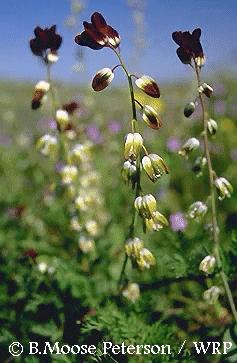Endangered Species Recovery Program | |
|
Home | News | Publications | Species profiles | Data and maps | About | Staff | Links | Department of Biological Sciences | CSU Stanislaus |

Photo © Moose Peterson, WRP
California jewelflower
Caulanthus californicus
Status
U.S.A. and California Endangered
Life History
California jewelflower is an annual plant belonging to the mustard family. As is typical of annuals, both plant size and population size in California jewelflower can vary dramatically, depending on site and weather conditions. The stems are hairless and often branching. The upper leaves are egg-shaped and clasp the stem, unlike the leaves at the base of the plant, which are oblong. The maroon buds are clustered at the tip of the stem and contrast with the translucent, white flowers below. California jewelflower has elongated fruits that are flattened in cross-section.
Seeds of California jewelflower begin to germinate in the fall when the rainy season begins, but additional seedlings may continue to emerge for several months. The seedlings develop into rosettes (clusters of leaves at ground level) during the winter months, and the stem elongates as flower buds begin to appear in February or March. Flowering and seed set continue until the plants die, which may occur as late as May in years of favorable rainfall and temperatures. The flowers are pollinated by insects. Seed-dispersal agents are not known, but those that have been suggested for Caulanthus and related genera include gravity, seed-eating animals, wind, and water. California jewelflower probably forms a persistent seed bank.
California jewelflower is found in several plant communities, including Non-native grassland, Upper Sonoran Subshrub Scrub, and Cismontane Juniper Woodland and Scrub. Historical records indicate that this species also occurred in the Valley Saltbush Scrub community in the past. Herbaceous cover is dense at most California jewelflower sites. Native plant species, such as annual fescue (Vulpia microstachys), clovers (Trifolium spp.), red maids (Calandrinia ciliata), and goldfields (Lasthenia californica) comprised a high proportion of the vegetation at many of the known locations over several years. On the Carrizo Plain, California jewelflower occurs primarily on the burrow systems of giant kangaroo rats (Dipodomys ingens), another endangered species. California jewelflower has been reported from elevations ranging from approximately 75 to 900 meters and from level terrain to 25% slopes. Primary soil types at known sites are subalkaline, sandy loams.
Distribution
This species is endemic to California. The historical range of California jewelflower is based on specimens collected between 1880 and 1973. Nearly half of the collection sites were on the floor of the San Joaquin Valley in Fresno, Kern, and Tulare counties. Several other collections came from two smaller valleys southwest of the San Joaquin Valley: the Carrizo Plain (San Luis Obispo County) and the Cuyama Valley (Santa Barbara and Ventura counties). Three collections were from the Sierra Nevada foothills at the eastern margin of the San Joaquin Valley in Kern County. The remainder of the historical sites were in foothills west of the San Joaquin Valley, in Fresno, Kern, and Kings counties.
As of 1986, all natural occurrences of California jewelflower on the San Joaquin and Cuyama Valley floors had been extirpated. Today, known populations of California are confined to three areas in hilly terrain west of the San Joaquin Valley: the Carrizo Plain, Santa Barbara Canyon (adjacent to the Cuyama Valley in Santa Barbara County), and the Kreyenhagen Hills (Fresno County). The Carrizo Plain and Kreyenhagen Hills populations are on public land administered by the U.S. Bureau of Land Management, as is approximately 10% of the Santa Barbara Canyon population. Additional populations of California jewelflower may persist in the foothills of Fresno, Kern, and Kings counties, where potential habitat remains in private rangeland. However, access to historical sites in these areas has been restricted, so the presence of the species has not been verified in over 50 years. Several experimental introductions of California jewelflower have been attempted in Kern, Santa Barbara, and Tulare counties, but none of the populations have persisted.
The primary reason for the decline of California jewelflower was habitat destruction. Conversion to agriculture accounted for the loss of most sites, but those closest to Bakersfield and Fresno were destroyed by urbanization. Oilfield activity may have eliminated a few sites in the foothills at the western margin of the San Joaquin Valley. Potential threats to the remaining populations include competition from introduced plant species, pesticide effects on pollinators, and small population size. California jewelflower on private land in the upper portion of Santa Barbara Canyon is subject to cattle grazing throughout the growing season, but the magnitude of threat posed by livestock is unknown. Residential development also threatens the privately-owned portion of the Santa Barbara Canyon population.
Classification
Order CAPPARLES, Family BRASSICACEAE, Genus Caulanthus, Species californicus.
Subspecies
None.
Recent Synonyms
None.
Other Common Names
None.
References
Buck, R.E. 1993. Caulanthus. Pp. 410-412, in The Jepson manual: higher plants of California (J.C. Hickman, ed.). Univ. California Press, Berkeley, 1400 pp; California Natural Diversity Database, Sacramento; Skinner, M.W., and B.M. Pavlik, eds. 1994. Inventory of rare and endangered vascular plants of California. Fifth edition. Spec. Publ. No. 1, California Native Plant Society, Sacramento, 338 pp.
Size
Stem:
10-50 cm
Fruit:
1-6 cm
Identification
California jewelflower differs from all other species of Caulanthus in that it has flattened, sword-shaped fruits and spherical seeds. Other jewelflowers also have maroon buds and whitish flowers, but those that overlap in range with California jewelflower have narrow, elongated fruits and flattened seeds.
Authors of Profile
T.M. Sandoval and E.A. Cypher